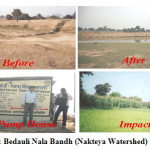Watershed Programme: An Innovative Way to Solve Scarcity and Provide Security of Water in Rural Areas for Sustainable Human and Social Development – Some Cases
Archana Nath 1 , Ritesh Kumar2 * and Ajit Kumar Behura1
DOI: http://dx.doi.org/10.12944/CWE.10.3.15
Sustainable development is now the much talked about term in the modern society owing to the increasing concern for the degrading environment. Water is the basic unit of life and without it one cannot think of the development in any form. In the present paper an attempt has been made to explain the concept of watershed management and show how effective such watershed project can be in enhancing the availability of water in the rural areas that suffers immensely owing to the situation of huge scarcity of water both in quantity and quality. Such approach can be highly effective in addressing the water scarcity issue and achieving the sustainable development and broadly the overall socio-economic benefit in the rural society. The present paper shows that such attempts under watershed activities like treatment in upper catchment, terracing of a piece of land on slopes, etc. helps in recharging of the wells that acts as a catalyst and further triggers the developmental activities in and around the catchment areas.
Copy the following to cite this article:
Nath A, Kumar R, Behura A. K. Watershed Programme: An Innovative Way to Solve Scarcity and Provide Security of Water in Rural Areas for Sustainable Human and Social Development – Some Cases. Curr World Environ 2015;10(3) DOI:http://dx.doi.org/10.12944/CWE.10.3.15
Copy the following to cite this URL:
Nath A, Kumar R, Behura A. K. Watershed Programme: An Innovative Way to Solve Scarcity and Provide Security of Water in Rural Areas for Sustainable Human and Social Development – Some Cases. Curr World Environ 2015;10(3). Available from: http://cwejournal.org?p=825/
Download article (pdf)
Citation Manager
Publish History
Select type of program for download
| Endnote EndNote format (Mac & Win) | |
| Reference Manager Ris format (Win only) | |
| Procite Ris format (Win only) | |
| Medlars Format | |
| RefWorks Format RefWorks format (Mac & Win) | |
| BibTex Format BibTex format (Mac & Win) |
Article Publishing History
| Received: | 2015-07-07 |
|---|---|
| Accepted: | 2015-08-28 |
Introduction
Studies reveal that the water scarcity cannot be ignored right through the world. A prediction study of United Nations Environment Programme (UNEP) reports that about 2000 million people would suffer due to water crisis by 2050. It also reveals that nearly one-fifth of the world’s population would access unsafe water for drinking purpose. Exploitation of groundwater in unplanned and unscientific manner has caused both hydrological imbalance and degradation in quality. As a result, the water level is going down day by day which requires more energy for pumping out the water from higher depth level or far away distance where water resource is available.
Effective use of land and water resources leads to the development of a country as these are the fundamental resource for any development. Water resources have always held a very key position in the life of human being. The demand in water resources is increasing gradually in order to meet the need of fast growing population for intended industrial, agricultural and domestic use. It is the foundation for socio-economic development of the region through employment and income generation, wealth of the people by eradicating the poverty and leading the entire nation towards sustainable development with holistic approach. India’s majority of the population relies on agriculture as their source of livelihood. Agriculture forms the backbone of India’s economy. The country frequently faces drought situation in several areas due water scarcity. The dry land areas often come across drought situation and in order to fight such problems integrated watershed concept is the most suitable one to go for. Singh et al. (2005) state that only watershed approach is the most important method for providing visible benefits to the rural areas by encouraging people’s participation in watershed programmes.
The term “watershed” is defined as an area or entity, comprising a set of hydro-geological units whose runoffs drains out through a common point. In this regard watershed is considered to be synonymous with catchment and drainage basin (Pereira, 1973). Wani et al. (2008) claims that watershed is not simply a hydrological unit but also it comprised with the components of social, political and ecological elements, which plays a crucial role in determining food, social and economical security within the entity and serves the rural people with all types of infrastructural and socio-economical facilities in life-supporting aspects of the watershed area. The watershed programme is primarily a land based programme, which is increasingly being focused on water, with its main objective being to enhance agricultural productivity through increased in situ moisture conservation and protective irrigation for socio-economic development of rural people (Joshi et al., 2006; Joshi et al., 2008).
In the same way, watershed management concepts recognize explicitly the interrelationships among land use, soil and water and the linkages between upstream and downstream areas. The concept of watershed management has evolved to ensure effective use of both natural and social capitals. The watershed management is nothing but the effective use of natural resources such as land, water and manpower resource for the sustainable development of the entity bound within the natural boundary determined by the geomorphological features. Thus, the watershed development programmes include land, water and human resources as essential components.
Watershed Management and its Importance to India
In a country like India, where a lot of running water goes waste, it becomes very important to apply the technology of watershed management to solve its annual problems of droughts and floods. Majority of India’s population depends on the occupation of agriculture and about 65% of the total arable land (142 million ha) in the country is rain-fed. Hence, the watershed programme would be an effective approach for the sustainable development of the country uplifting the backward rural areas as good as the urban ones. An evaluation study reports that the large rain-fed areas of the country have been classified as the areas under low productivity, high risk and uncertainty in production, low level of technological change and vulnerability to degradation of natural resources (Joshi, et al, 2008). Almost all major international developmental agencies like World Commission on Environment and Development (WCED), Food and Agricultural Organization (FAO), and Consultative Group on International Agricultural Research (CGIAR) and its allied agencies amongst others have emphasized sustainable use of water and other natural resources. For the last two decades, the sustainable use of land and water resources has also drawn a wider attention among policy makers, administrators, scientists and scholars of India. Such watershed management approach is definitely going to help states like Rajasthan, Madhya Pradesh, Parts of Bihar, etc. where water problems exist owing to the scarcity of water in the region.
Objective of the Study
The prime objective of the present study is to understand the concept of watershed programme through case studies and its effectiveness in addressing the rural people’s first need in the form of water, especially in the rain-fed and arid regions that suffer with extreme water scarcity. Two case studies are being shown here to justify the running of such developmental projects in addressing the serious issue of water scarcity and solving the rural people problems.
Some Case studies
Case Study I: Nakteya Watershed Project, Dhobi Block, Gaya Ditrict, Bihar
The Problem
Two villages namely, Bedauli and Masaundha are the focal points in the study and these falls under Nakteya Watershed region. The area suffered from huge water scarcity problem and that was proving root cause and barrier in the development of the area. Some other causes included poverty, livelihood problem, adverse climatic condition, land not suitable for agriculture, unemployment, etc. and the result was that people of the two villages were slowly leaving the villages for their livelihood.
The Approach
In order to solve the water scarcity problems in the Nakteya Watershed that contains two villages, which is the major problem of the watershed area beside the need for overall developments, the watershed programme was introduced. The project was implemented by Magadh Vikas Bharti and it was funded by National Bank for Agriculture and Rural Development (NABARD), Patna. Some of the activities that were taken under watershed programme include: area treatment, drainage line treatment and watershed plus activities for sustainable rural livelihood development.
The Result
The pre-watershed and post-watershed results of various activities clearly shows that changes in terms of additional area brought under cultivation, improvement of existing crop land, increase in cropping intensity, introduction of better technology and tree based cropping. Besides this, the changes in animal population, milk and other products, introduction of new activities like fishery, stal-fed goat rearing etc. and the status of fodder availability shows the impact of such programmes and the benefits that arise from such activities. All this was possible due to availability of water due to coming up and implementation of such watershed programme in the area where people was struggling badly to survive and were leaving the village for livelihood.
The present study has clearly brought in the benefits that a watershed programme can have with respect to the conservation of water. This can be seen from the changes that have taken place in the two villages under the Nakteya watershed due to the implementation of the watershed project. Improved agricultural production and increased access to drinking water are the common outcome of successful implementation of watershed development programme.
The photographs related to conservation and management of water resources and its impact have been shown in the Fig. 1(a) to 1(e) below.
|
|
|
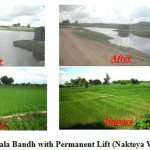 |
Figure 1(b): Bedauli Nala Bandh with Permanent Lift (Nakteya Watershed) Plot: 1A Click here to View figure |
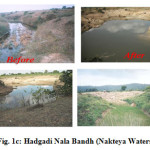 |
|
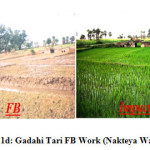 |
Figure 1(d): Gadahi Tari FB Work (Nakteya Watershed) Click here to View figure |
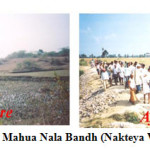 |
|
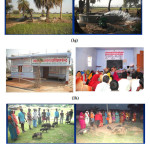 |
|
Case Study II: Jamuwanikala Limestone Mining Project, ACC Limited, Kymore Cement Works, Katni, Madhya Pradesh
The Problem
Jamuwanikala Limestone Mining Project is located at village – Jamuwanikala, Tehsil Vijayraghaugrah, District Katni, MP. Any industrial activities require huge quantity of water for its various activities. A study was carried out with respect to the mining and associated activities at Kymore to find out whether such industrial activities are adversely affecting the water scenario on the surrounding area of mines of Kymore Cement Works as far as quality and quantity are concerned.
The Approach
Although industrial activities involves lots of consumption of water, ACC management has taken all possible effort to conserve and presrve water in and around the activities area in order to meet the requirement of water for one and all. Water management strategies have been formulated based on techno economic feasibility and recharge potential of the area. Under the green umbrella of watershed programme various conservation activities are being taken by the ACC management. This can be seen from various conservation method adopted by the ACC management that includes Nala Bunds (NB)/Gully Plugs (GP), Drainage Flow Diversions (DFD), Contour Bunding (CB), Percolation Tank (PT), Contour Trenching, Bench Terracing, Terrace system and Stone Terracing.
Following measures are being adopted as part of the management plan to conserve the water:
1. Part of the excavated portion of the pit is to be used for water harvesting.The rain water accumulating in the quarries of mined out areas in the mining watershed regions may be used for dust suppression and green belt development. Thus, utilization of harvested rain water in the mining watershed areas may effectively meet the need of the mining activities by conserving the water requirement without depending upon other natural resources.
The sump water will also be readily available for irrigation purposes for the surrounding area.
Water is perhaps the only replenishable natural resource, but may not always be accessible or available for direct use to human beings. Hence, a bypass to this natural phenomenon, artificial recharge is thought of most frequently. Rainfall is major source of water for drinking, agriculture and industries. Water storage schemes are aimed for an integrated management and utilization of water resources.
There is no major river within the core zone and buffer zone within 5 km radius. A few seasonal Nalla originating from the Kymore range flow down the escapement and drain in Katni/Mahanadi river which flows about 8 km south of the mining lease area. The seasonal Nalla are active only for a few hours after rain. These Nalla have been re-routed/diverted between the inlet and outlet of the Mining Lease to keep the mine active areas free of water by ACC management. Since the rainfall is major source of water for drinking, agriculture and industries, the present net work of rain water collection has been made effective at various location in the entire area from the Kymore foot hills to cement plant water reservoirs as well as near to the mine pits.
The rainwater in the area is collected in the worked out mine pits which have been converted to water reservoir. Most of water requirement of cement plant and colony are met from the reservoir after necessary treatment.
As primary purpose of the artificial recharge is to obtain adequate amount of water at a required time for near future usage, the adoption of the following mitigation measures are being practiced,
- Use of worked out mine pits as reservoir
- Widening/ deepening of the nalla constructed by ACC Kymore named as “ Harvey nallas” of the and maintaining its cleaning before monsoon
- Extension of Harvey nalla along forest foot hills for collection of more quantity of water during monsoon
- Some schemes involve the impoundment of water of runoff into ditches, ponds, tanks and man made reservoirs
- Operating water reservoirs to suit downstream requirements and encourage wildlife around reservoirs
- Monitoring ground water levels.
- Construction of check dams over the Kymore forest hills in association with the MP Forest department.
- The road drainage system to receive the hill water and to discharge into the surface water trains.
- Afforestation /Greening Kymore Hill Project in association with M.P. Forest Dept.
- Plantation in and around the surrounding areas
- Future plans for making soak pits near bore wells located at several villages to capture the waste water all around and to help recharge at the spot.
The Result
The stored water in the quarries is playing a vital role as a water recharging system of the ground water aquifers in the watershed areas. The study of the limestone mining areas has revealed that the rainwater harvested quarries and the recharged zones have a beneficial impact on the water resources as the water from the quarries is pumped out and made available for various intended uses. The mining activities are not having any adverse impact on water quality.
The result of such effort can be seen clearly from the various pictures shown in Fig. 2 and 3. The photographs related to conservation and management of water resources have been shown in the Fig. 2 and Fig. 3 below.
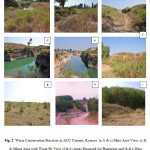 |
Figure 2: Water Conservation Practices at ACC Cement, Kymore. (a, b & c) Mine Area View, (c & d) Mines Area with Water Pit View (f & g) Areas Proposed for Plantation and (h & i) Best Practices at ACC Cement, Kymore Click here to View figure |
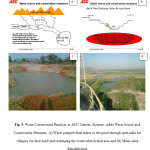 |
Figure 3: Water Conservation Practices at ACC Cement, Kymore. (a&b) Water Source and Conservation Measures, (c) Water pumped from mines to the pond through open nalla for villagers for their need and recharging the water table in their area and (d) Mines Area Rehabilitation Click here to View figure |
Environmental Significance of such Programme
Such watershed programme holds environmental significance. It provides a convenient platform to address socio-environmental issues. From the case study I one can see how the successful implementation of watershed activities has changed the socio-economic status of the weaker sections of the rural society including the conditions of the women. From the case study II it has been shown how good practices from industries not only help their existence in the society at the same time such development projects also bring in several advantages for the rural community in and around the industrial complexes. Through the best practices of watershed the industry not only manages the huge amount of water required for the industrial as well as colony uses it also benefits the rural community in getting the regular supply of water for their daily uses.
Conclusion
Sustainable development can occur only when the needs of people and the capacity of the natural resource to meet those needs are balanced over the time. Watershed management provides a convenient framework to the country for moving toward the equilibrium state of the demand of the people and the supply of the natural resources. So, the case studies presented herein has clearly shown how a watershed programme can help the conservation of water and in overall socio-economic development of the region. This can be seen from the changes that have taken place in the areas where such project has been implemented. The three-fold attributes of the overall watershed development programme are (i) promoting economic development of the rural area, (ii) employment generation, and (iii) restoring ecological balance. Similar projects when it is undertaken by any industries it also helps in the overall development of the region.
Acknowledgement
I am thankful to the Magadh Vikas Bharti for sharing their information on watershed project and its successful implementation in a very critical region. I am also thankful to ACC Management for giving me opportunity to work on a hydro-geological investigation project. Lastly, I would extend my gratitude to my Director, Amalendu Sinha for permitting me to publish the paper.
References
- Singh P., Behera H. C. and Singh A., Impact and Effectiveness of “Watershed Development Programmes” in India. (Review and Analysis Based on the Studies conducted by various Government Agencies and other Organizations). Retrieved from http://dolr.nic.in/dolr/downloads/pdfs/Impact%20and%20Effectiveness%20of%20WDP%20by% 20LBSNAA.pdf
- Wani S. P., Sreedevi T. K., Reddy T. S. V., Venkateswarlu B. and Prasad C. S., Community Watersheds for Improved Livelihoods through Consortium Approach in Drought Prone Rain-fed Areas, Journal of Hydrological Research and Development, 23, 55-77 (2008).
- Joshi P. K., Vasudha, P., Shiferaw B., Wani S. P., Bouma J. and Scott C., Socio-economic and Policy Research on watershed Management in India: Synthesis of Past Experiences and Needs for Future Research, SAT e-Journal, August, 2(1) (2006). Retrieved from (http://www.icrisat.org/Journal/agroecosystem/v2i1/v2i1soci.pdf)
- Joshi P. K., Jha A. K., Wani S. P., Sreedevi T. K. and Shaheen F. A., Report no. 46 on Impact of Watershed Program and Conditions for Success, A Meta Analysis Approach, International Crops Research Institute for the Semi- Arid Tropics, Andhra Pradesh (2008).
-
Pereira H. C., Land use and Water Resources in Temperate and Tropical Climates. London, Cambridge University Press (1973).


